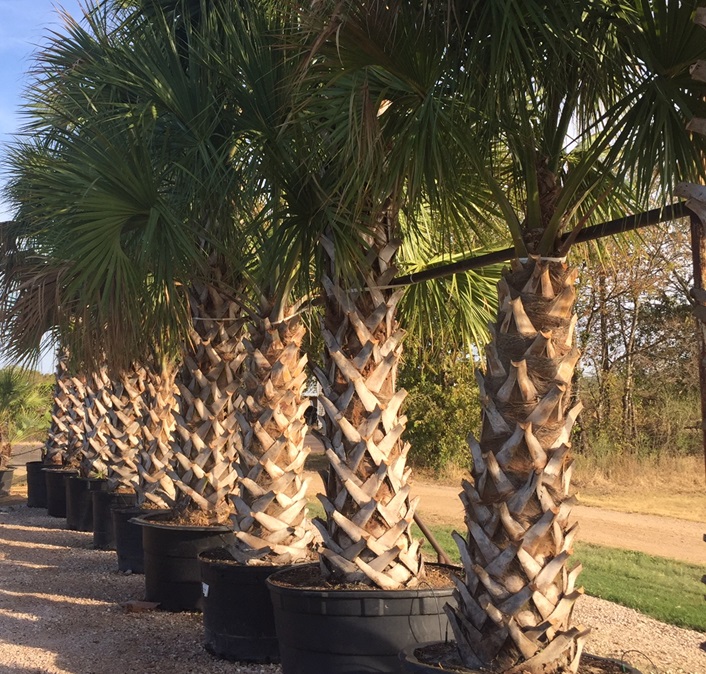It is a “given” in Central Texas that certain popular varieties of plant material will sustain a freeze, eventually, that will cause extensive damage or even death. I receive many questions, daily, following an unusually cold period, about how to deal with plants that appear to have frozen and what to do with them. Here are a few that may have experienced damage, and some suggestions on how to deal with them.
Little John Bottlebrush: Although this plant is rated for Zone 9, it is used extensively in this area, as it is both deer resistant and drought resistant. We occasionally get an extended freeze in the low 20’s or teens that will kill it, but do not consider it dead until you scratch the bark at the base and see if there is tissue that is still alive. If so, in late February cut it back to healthy tissue, mulch the roots, and wait.
Scarlet Bottlebrush: This plant is actually Zone 8, but we sometimes experience Zone 7 freezes. Check for live tissue as described above, and there is a chance that it will come back. It may be cut back to the ground in late February and come back quickly if the roots are not damaged. If only the tips of the branches are affected, shear them off in late February as well.
Woodlander’s Hardy Bottlebush: This Zone 7 plant experienced a little tip browning from the cold temps. Trim the brown tips off and shape the plants before new growth begins in the spring.
Sago Palm: Another Zone 8 plant that will be damaged in the mid-to-low 20’s. If the leaves are brown, cut them off at the trunk. Most years, new growth will come out in the spring and the plant will recover nicely.
Confederate Star Jasmine: This vine is also rated Zone 8, but a sustained freeze will often kill it back, sometimes to the ground. Scratch the vines to see if there is still green under the bark. If there is, cut the top back a few feet if it is tall, and wait for it to leaf out. If the tissue seems dead, cut the plant back to the base, mulch for the rest of the winter, and wait to see if it will come back from the base.
Primrose Jasmine: This large shrub is rarely killed by a freeze, but can be defoliated by temperatures in the mid-20’s. A light shearing in late February will help it to come back fuller and more uniform in the spring. If it is an old, woody plant, cutting it back to the ground will often rejuvenate it so that it comes back looking fresh.
Mexican Fan Palm: This is another plant that is not considered winter-hardy here, and it is damaged more winters that not. If you are lucky, the leaves will be killed and the “growing tip” will survive. Many people will spray the “growing tip” with copper fungicide right after a hard freeze to prevent disease from killing the tissue under the “growing tip” that will divide and form new growth in the spring. If you can reach the newest leaf that has not yet unfolded (it looks like a “spear”), gently pull on it. If it is tight. it will most likely be ok, if it pulls out, probably not! These palms will NOT come back from the base.
Citrus Trees: If your Citrus trees were planted in the ground, and established for at least one year, you should wait until late February to prune the dead out. It should be quite obvious by then what branches were damaged. Depending on the exposure they are planted in, there will be varying degrees of damage. Southeast exposures are the most protected and the northwest is the most exposed to cold temperatures. Satsuma Mandarin Oranges and Meyer Lemons have the best chance of revival, but Limes are not as cold tolerant and may not revive. Remember, all except the Arctic Frost Satsuma and Orange Frost Satsuma are grafted plants, so if the new growth comes back below the graft, it will not be the same plant.
Bicolor Iris: These plants may take a hit with the freeze, but should come back nicely this spring. If the plants were heavily damaged, cut them back to 6” tall in late February before the new growth starts in the spring. If there are only a few brown leaves, simply pulling them out should make them look better.
Butterfly Iris: This relative of Bicolor Iris is seldom evergreen in Central Texas, and almost always freezes back to the ground and comes back. However, with sustained freezes in the 20’s, it may not come back. Again, wait and watch.
Variegated Flax Lily: Again, the survival of this plant depends on the exposure they were planted in. In a protected micro-climate they usually come back after a hard freeze, but with extended freezes in the 20’s, many are goners. It is such a desirable plant, I will absolutely re-plant this plant in my yard this spring. There are so few deer-resistant colorful plants for shade or sun, it is well worth using this plant and replacing when our weather goes awry.
Split-leaf Philodendron: Used as a deer-resistant plant for the shade, these are often hit by freezes, but will come back if it is not too cold for too long. Sustained hard freezes are usually fatal. Check the stem near the ground and if it is mushy, pull the plant and replace in the spring.
Giant Leopard Plant: These large-leaved deer-resistant plants for the shade are evergreen most winters in Central Texas. If yours took a hit this last freeze, don’t despair. Cut it back and wait for spring growth.
Oleander: There are many varieties of Oleander, some of which are winter-hardy in Zone 8, and some which are not. The Zone 8 Oleanders, such as ‘Hardy Red’, ‘Hardy Pink’, and Turner’s Trey Boy may be cut to the ground if there is measureable freeze damage. They will come back prettier from the ground than from just pruning the damage off. Oleanders rated zone 9 or 10 often will not come back from an extended freeze.
Thryallis: This pretty flowing shrub may also take a hit with the freeze, and the damage depends on how long it had been established and the exposure it is planted in. Some only dropped leaves and may need a shaping prior to leafing-out, but some will need to be cut back to the ground. Scratch the twigs to see how far back these have frozen to decide how much to prune.
American Agave (Blue Agave): This plant can take a hit in some winters when sustained freezes in the 20’s occur, and may need to be removed and replaced. Luckily, they produce numerous “offsets” which may have survived the freeze better than the parent plant. If so, they may be planted to replace the frozen plant.
Bush Germander: These shrubs may also be damaged by extreme freezes, again in varying amounts, depending on establishment and exposure. If the twigs still scratch green, shear them back a little in late February to shape them. If not, cut them back to the ground and WAIT until warm weather to see if they will come back.
Pride of Barbados and Esperanza (Yellow Bells): If these plants are well-established going into the winter, there is a good chance they will come back when the soil warms up. Cut them back to the ground in late February, then WAIT!! They are often the last plants to come out in the spring, and the ground needs to REALLY warm up first! Practice patience with these plants, as it can sometimes be late April to May before we see signs of growth.




